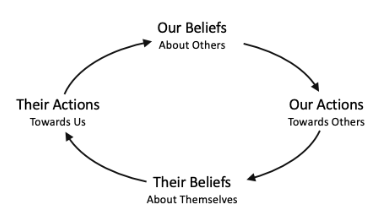Leadership and Management Programme
At a Trust of Schools around Maidstone, in Kent, England
Introduction:
The Leadership and Management Programme was a comprehensive initiative designed to bridge the gap in leadership skill development within the trust of schools. In the educational sector, effective leadership is not merely desirable but essential for fostering growth, driving innovation, and nurturing a thriving learning environment for both staff and students alike.

The programme’s aims were to equip both senior and middle leaders with the essential skills and competencies needed to navigate the myriad of challenges faced within the education sector.
The specific objectives for the programme were:
- Cultivating a well-rounded leadership skill profile that encompasses both people-oriented (leadership) and task-focused (management) approaches.
- Providing participants with practical tools and strategies to enhance their leadership effectiveness within their diverse settings.
- Fostering a culture of collaboration, innovation, and continuous improvement both within and across the schools in the trust.
At the heart of the programme design was a data-driven approach which began by conducting a comprehensive data collection exercise involving over 100 staff members across various levels within the trust. This exercise provided valuable insights into the specific leadership needs and challenges being faced.

This spider graph shows the extent to which the respondents of the survey felt they were being motivated within each of the 10 styles.
This was determined through a multi-layered survey which both directly and indirectly asked the participants whether they felt they were being motivated in each specific way.
From this it became clear that the majority of the respondents were being motivated through:
- The need to achieve high results.
- The atmosphere and culture of the team around them.
- Being in a nurturing environment.
The lowest driving factors however were:
- Having problems to solve.
- Receiving recognition or their efforts and results.
- Feeling motivated by the resources and infrastructure around them.
In other words, the external motivational languages being used across the trust are disproportionate towards future targets and results, and less towards the recognition of this journey.

Although the results from the spider graph were quite powerful on their own, the second layer of analysis looked at the open responses in conjunction with this through a thematic analysis, and revealed the level to which the respondents felt their personal motivation style was being met by those in leadership positions.
The analysis drew out a measure of “motivational resonance” which we defined as the synergy between the motivational language being used by those in leadership positions and the motivational driver of the respondents.
From this, we found that less than 20% of respondents had a high level of “motivational resonance”, meaning they felt motivated by the leadership they were directly experiencing. While over half of respondents felt they were somewhat being motivated by the leadership.
However, 30% (or nearly a third) of respondents did not feel the leadership they were experiencing was was directly motivating them. When this is combined with the spider map, it is clear that there are skills missing which are directly linked to the way in which the respondents are experiencing their workplace and ultimately their motivation to work.
Programme Design:
Based on the findings from this data collection phase, the designed curriculum was tailored to addresses these identified gaps and priorities. A two-year program was determined to be the best model to use, with this mirroring an existing program within the trust schools and providing the space and time for the programme to have a measurable impact. Equally it allowed for a comprehensive approach o leadership development around school term-times and the demands on time of the individuals who would be attending the programme.
The following sessions were decided upon and designed in order to provide a development pathway towards improving the leadership practices of the participants, and in doing so address the “Leadership Profile” and “Motivational Resonance” of the trust.
Year 1:
- Why Leadership Matters
- Self-Awareness and Predisposition
- Vision, Values and Strategy
- Discretionary Effort, Courage and Resilience
- Decision Making
- Emotional Intelligence and Clarity
- Little Things that Matter and Consistency
- Personal Organisation
- Humility and Prioritisation
- Different Leadership Styles
Year 2:
- Performance Management and Coaching
- Monitoring and the Use of Data
- Managing Change
- Context, Teams and Teamwork
- Delegation
- Holding Effective Team Meetings
- Motivation, Influencing Others and Managing Up
- Managing Conflict and Having Difficult Conversations
The programme design integrated a blend of interactive workshops, one-to-one coaching sessions and a reflective logbook to ensure maximum engagement of the ideas and models being explored, alongside continual reflection and development. In parallel to this was an action-oriented project which provided a practical application of the learning within a specific element of their job role.
Who Attended the Programme?
It was decided that the programme would be made optional for those either in a leadership position or aspiring to be. The thought behind this was to develop a programme which could be implemented again and again, and over time develop a strong leadership culture within the trust and having a long-lasting impact.

As such, attendees have been new executive head teachers, heads of school, and deputy heads, all the way through to classroom teachers looking to make the next step up the ladder.
By bringing together different levels of leadership experience, the workshops could be facilitated in such a way that ideas and experience of those within the room could embellish the models and ideas being shared within the sessions. In this way, the participants of the programme would be working in partnership with each other and the facilitators, giving shared ownership and adding weight to the work they are doing to develop and grow.
What Models and Ideas did We Use?
One of the models which was developed is shown below, where we have adapted some of the reflective leadership questions from John C. Maxwell and put them into a pyramid of reflection, taking us from self-leadership through to outward leadership.

In doing so, we built from our why leadership is important session where we first share how self-leadership and self-regulation is important in order to be able to influence and inspire others. The second session took this further into self-awareness, before reaching the session where we bring this together within this reflective pyramid where we encourage leaders to answer from the bottom upwards.
As the development programme turns more towards outwards leadership, different models come in to play to help develop an understanding of the impact on others of our decisions and leadership as a whole.
One of the first models we used was the Pygmalion Effect, exploring how as a leader our internal beliefs can impact the beliefs and actions of others unless we start to change our mindset and lead ourselves differently. When we are intentional about our words and actions with others we can have a positive impact on their self-belief and actions which in turn will feed in to the way we think, act and interact.

We go on to many other models, but an example here would be looking at the grief-curve within the context of a change within the workplace.

How individuals would go through these stages at different rates, from those who may go through this within a single meeting and be on the experimentation phase before they leave the room (the early adopters), to those who will still be in shock or denial at this point and take weeks or months to reach awareness or acceptance (the resistors).
Through different models, being shared within different contexts at different points throughout the two-years the participants of the programme were able to build and develop on prior learning and experience, and in doing so develop and grow their leadership awareness and ultimately their leadership competency.
Programme Testimonials:
The course, created from scratch, exceeded all attendees’ expectations, providing invaluable insights, advice, guidance and practical skills that are crucial for effective leadership and management in any organisation.
From the outset of the course beginning and launching in 2021, the content stood out for its highly personalised approach with Chris ensuring each person had bespoke and highly individualised feedback based on their own project for the school setting they are in.
Chris made a concerted effort to understand each participant’s unique background, strengths, and areas for growth and development. This personalised feedback was not only comprehensive but also delivered in a manner that was constructive, positive and encouraging. This wasn’t generic advice, but tailored recommendations and advice that took into account the individual goals and current challenges in each school setting. This level of personalisation helped everyone to understand their leadership style and identify specific areas where they could improve.
Reflecting on Chris’ expertise, friendly manner and approachable demeanour created a learning environment that was both stimulating and supportive. His ability to distil complex theories into digestible sessions, coupled with his genuine interest in everyone’s personal development, made the course incredibly effective for everyone taking part.
Chris has an extraordinary, and rare, talent for creating a learning environment that is both challenging, reflective and supportive. He ensured that each module of the course was supported with relevant content and practical exercises that resonated with our school-based experiences. His ability to break down complex leadership concepts into understandable and actionable lessons made the learning process seamless and incredibly impactful.
Chris’ expertise, guidance and dedication were evident in every aspect of the course, from the meticulously crafted curriculum and individual planning of each session, to the engaging and dynamic delivery – during each session, Chris always managed to make us smile. His genuine passion for leadership development was infectious, inspiring everyone on the course, over both cohorts, to strive for excellence.
Gilly, Director of VITT
I have been attending a Leadership & Management Programme for the past year delivered by Chris.
The course content and the structure of sessions review relevant models, allow discussions to challenge our perception of what Leadership is, and provide practical support and guidance on how to become a better Leader.
The delivery of sessions are done so by someone who is extremely passionate about this area and Chris creates a very engaging and inclusive learning environment.
Lucille, Programme Attendee
